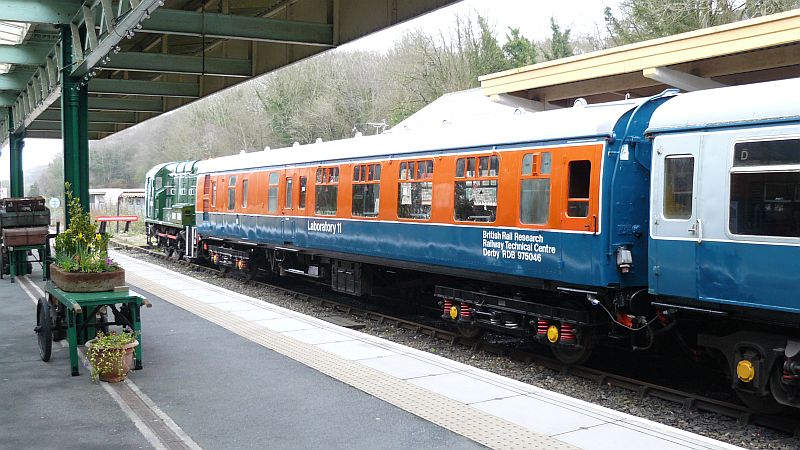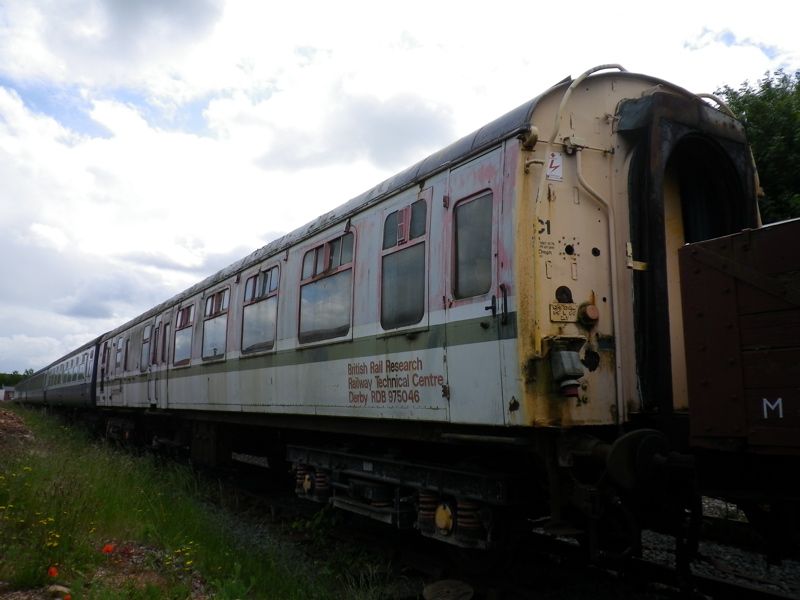RDB 975046 'Lab 11'
 Lab11 at Okehampton, ready for service at Easter 2015 |
Lab 11 began life in 1951 as BR Mk1 Brake Second Corridor (BSK) S34249 at Ashford/Eastleigh, built to diagram 181, on lot number 30021. Initially it worked between London and Ramsgate then from 1963 it was part of a boat train from Waterloo to Southampton Docks connecting with the ferry to St Malo. It was withdrawn from revenue earning service in February 1970, and converted in June 1970 to QXX RDB 975046 'Laboratory 11' to form part of the Tribology Test Train (see below), with which it entered service in 1972.
The interior was rebuilt to provide a control bay in the former seating compartments which contained computerised data collection and recording equipment, as well as many different control modules for the Trib brake slip/slide units. The guard’s office was retained, but the luggage compartment was fitted with a generator providing power for onboard electrical equipment. Lab 11 initially carried the blue/orange research livery, and later carried the Railway Technical Centre ‘Reverse Executive’ livery.
It last ran in this guise in 1996, and was disposed of in 2004, arriving on the railway in Sept 2011 via the Great Central Railway. DRA (then DRSA of course) C&W volunteers restored it to its original Research Division livery. The restoration suffered a major setback when Lab 11 was the subject of a graffiti attack in April 2014, but DRA's C&W team took a deep breath and got stuck back into re-finishing it, getting it into service in spring 2015. The interior has been fitted out with tables and loose chairs, and as a dual-braked brake coach with a generator and a kitchen, Lab 11 is a very versatile vehicle.
DRA is indebted to Okehampton United Charities and an anonymous benefactor for financial assistance with the restoration.
Elsewhere on the website is a gallery of photos of the restoration. See also the museum reopening gallery.
 Lab11 prior to restoration in 2011 |
Owner:Dartmoor Railway Association
Condition:Operational
Return to stocklist
The Tribology Train
Tribology is the study of interacting surfaces in relative motion. This includes lubrication, lubricating oils and greases, contact mechanics, friction, wear, surface damage, surface modifications and coatings.
The 'Trib Train' was used to investigate the issue of low friction between wheel and rail. It entered service in 1972 and was used to verify laboratory tests on surface contaminants on the railhead. It was also used to assess the effectiveness of rail head treatment of the time such as water cannons. In the early years of wheel/rail interaction research, the Trib Train travelled 14,000 miles in one 12-month programme alone.
It was a three vehicle formation consisting of Laboratory 11 (RDB975046), a monitoring van COV-AB (RDB999900) and an auto-trailer (RDB975076). It usually had motive power from the Research Division's own pool of locos including the Baby Deltic 5901, Class 24 24061 'Experiment'(later renumbered 97201 and withdrawn at the end of 1987), and the original Class 31 which was unfortunately destroyed by fire.
The COV-AB was one of a batch of ten fitted with experimental 'Taperlite' suspension and housed the instrumentation and hydraulic packs, with special brake actuator units above each axle as well as tanks for laying fluid during the experiments. It had no conventional brakes and was fitted with end gangways for access.
The last extensive use of the Trib Train to measure naturally occurring adhesion was in the early 1990s when a significant amount of measurements were taken to survey typical adhesion profiles on a number of routes. The final use of the Trib Train was in 1996 to compare the performance of portable tribometers with a full-scale tribometer to calibrate the former. The Trib Train was not used after this and was eventually disposed of by AEA Technology Rail in 2004 to the Great Central Railway (Northern).

 Home
Home